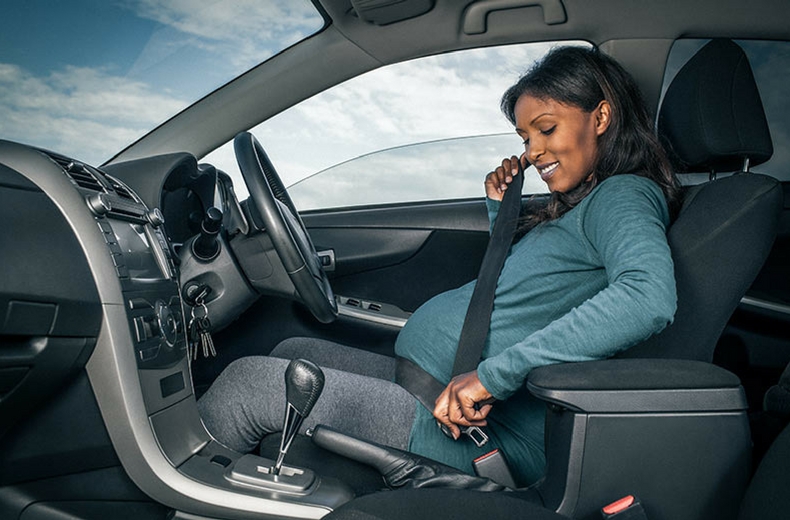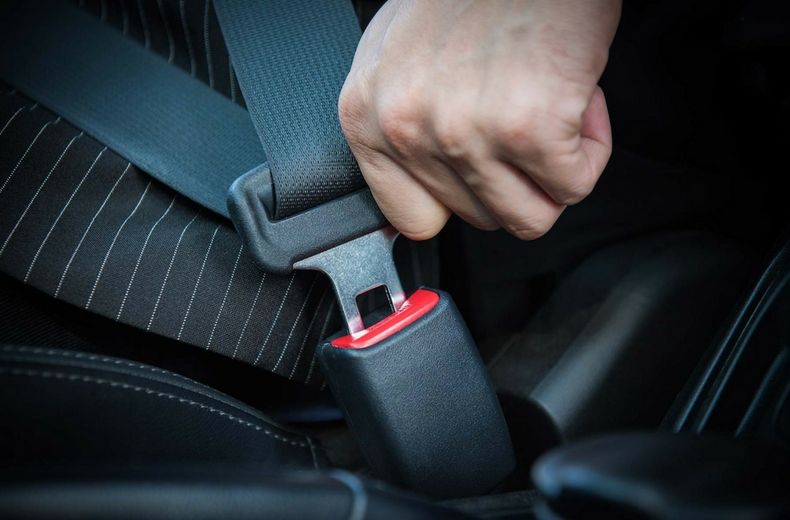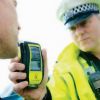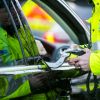We all know the reasoning behind the legislation – the safety implications for not wearing one is a no brainer – but do you know what happens if you’re caught driving without a seat belt? Or who's responsibility it is if your passenger refuses to use theirs? And are there any exemptions from the law?
Our comprehensive guide answers your questions, offering all you need to know about seat belt legislation.
What is the seat belt law?
Essentially, if your vehicle has seat belts you legally have to wear them.
It's unlikey your vehicle will not have seat belts unless it's a very old classic as it’s been a legal requirement in the UK for seat belt anchorage points to be fitted in the front of all new cars since 1965, and for front seat belts to be fitted to all cars since 1967.
The law was also changed in ‘67, requiring all cars manufactured since ‘65 to be retro-fitted with front seat belts.
By 1987, all new cars sold in the UK legally had to have rear seat belts fitted too – but most manufacturers were already fitting them as standard.
The law changed in 1989, making it a legal requirement for children travelling in the back of cars to wear seat belts, followed by another rule change in 1991 which dictated adult passengers must also wear seat belts in the back of cars.
With front and rear seat belts a legal requirement for all new cars for 30 years – and legislation dictating that they must be worn since 1991 – wearing a seat belt ought to be human nature to anyone when getting into a car in the UK.
Of course, it’s not as simple as ‘everyone should wear seat belts’.
Children should be secured using appropriate child seats, and even animals need to be restrained (yes, the Highway Code says so).
Our table below shows simply how UK seat belt law applies to different drivers and passengers:
| Type of traveller | Front seat | Rear seat | Responsibility |
|---|---|---|---|
| Driver | Pets | N/A | Driver |
| Child under three | Approved child restraint needed | Approved child restraint needed (exceptions below) | Driver |
| Child aged 3-12 or smaller than 135cm | Approved child restraint needed | Approved child restraint needed (exceptions below) | Driver |
| Child aged 12 or 13 or taller than 135cm | seat belt must be worn if fitted | seat belt must be worn if fitted | Driver |
| Passengers aged 14+ | seat belt must be worn if fitted | seat belt must be worn if fitted | Passenger |
| Pregnant women | seat belt must be worn if fitted unless with a doctor’s note | seat belt must be worn if fitted unless with a doctor’s note | Passenger |
| Pets | Animals must be suitably restrained to prevent injury | Animals must be suitably restrained to prevent injury | Driver |
Seat belt warning light
Many modern vehicles feature a seat belt warning light, which illuminates on the dashboard and informs the driver that a passenger (or the driver) isn't wearing their seat belt.
In some cases, the seat belt warning light will be accompanied by an audio tone that will gradually get louder until the seat belt is safely secured.
Many seat belt warning systems are weight or sensor activated, which means they may go off if you place a bag or heavy object on the seat.
A fault with the buckle, occupancy sensor or supplementary restraint system (SRS) can also result in the seat belt light illuminating.
Dogs in cars seat belt law
Rule 57 of the Highway Code states: “When in a vehicle make sure dogs or other animals are suitably restrained so they cannot distract you while you are driving or injure you, or themselves, if you stop quickly.
"A seat belt harness, pet carrier, dog cage or dog guard are ways of restraining animals in cars.”
Having loose animals in the car can be a distraction, and in the case of a crash they could cause serious injuries to themselves and other occupants in the vehicle if they’re propelled forwards as the car comes to a stop.
The RAC sells a dog harness which attaches to the seat belt, and a dog guard which can be used if your dog is travelling in the boot.

RAC sale – up to 33% off*
• Roadside cover from £5.29 a month†
• We get to most breakdowns in 60 mins or less
• Our patrols fix 4/5 breakdowns on the spot

READ MORE: Is it worth adding legal expenses insurance to your car insurance?
How to safely wear a seat belt when pregnant

Legally, you must wear a seat belt when you’re pregnant unless your doctor has given you a ‘Certificate of Exemption from Compulsory Seat Belt Wearing’.
This must be kept in the vehicle and must be shown to the police if they stop you and ask why you’re not wearing a seat belt. You’ll also need to tell your car insurance company.
The safest and most comfortable way of wearing a seat belt if you’re pregnant is:
- Position the lap belt (the bottom of the two) low on your hip bones and below your belly
- The shoulder belt should be positioned between your breasts and to the side of your belly
- The belt should be tight - if it’s too loose, it won’t hold you in place in a crash - and don’t be tempted to position the shoulder belt underneath your arm
Exemptions from wearing a seat belt
There are a few genuine exemptions to wearing seat belts. These include:
- Taxis
If you’re a licensed taxi driver ‘plying for hire’ or carrying passengers, you don’t need to wear a seatbelt, legally speaking. However, we recommend you should.
There are a number of suggestions why this is the case: one is because you’re expected to get in and out of the car regularly helping passengers, while some say it’s because wearing a seatbelt could make taxi drivers vulnerable to assault.
Passengers, however, must legally wear a seatbelt.
- Delivery drivers
Goods drivers travelling no more than 50 metres between stops don’t have to use their seatbelt between deliveries.
Be warned, though, a police officer might want proof that you’re only travelling a short distance and you could be fined if you’re travelling more than 50 metres.
- Medical exemptions
If you have medical reasons for not wearing a seatbelt, you’ll need to ask your doctor for a ‘Certificate of Exemption from Compulsory Seat Belt Wearing’.
With solid evidence that wearing a seatbelt can save lives in a crash, you might find your doctor reluctant to give you exemption from wearing a seatbelt.
You’ll need to make it clear why you feel you need it - and get a second opinion from another doctor if needs be.
If you are given a certificate, keep it in your vehicle and be prepared to show it to police if you’re stopped in your car.
When driving, it’s fairly obvious to observant police officers if you’re not belted up, so you might find yourself pulled over more regularly than you would be otherwise.
Wearing a seat belt on a minibus, bus or a coach
When travelling on a minibus, bus or coach, you must wear a seat belt if there’s one available.
Most modern minibuses and coaches (registered since October 2001) will have belts fitted throughout.
In minibuses, drivers must wear seat belts, while children can only travel in the front if a car seat or adult seat belt is fitted in the front.
The driver must ensure that children under three must use an appropriate restraint if sitting in the front, while those aged 3-12 and under 1.35 metres should use an appropriate restraint if available.
If not, they must wear a seat belt.
Older children must wear seat belts - while anyone over 14 is responsible themselves for belting up.
In the rear seats of small minibuses, passengers must wear seat belts or use an appropriate child restraint.
The driver is responsible for ensuring under-14s are suitably restrained.
In larger minibuses, under-14s are not required to wear seat belts but it is highly recommended.
EDITOR'S PICK: 10 driving offences you didn’t know were illegal
Punishments for not wearing a seat belt

If you’re caught travelling in a vehicle without wearing a seat belt - and none of the exemptions apply - you could be hit with an on-the-spot Fixed Penalty Notice of £100 (which will not carry any penalty points).
Remember, the driver is responsible for children aged up to 14 and you could be fined for each child passenger without a belt.
Those over 14 are responsible for their own actions - so if you’re caught not wearing a belt as a passenger, you could be hit with a £100 fine.
Not wearing a seat belt isn’t an endorsable offence, so you won’t be given penalty points on your licence if you’re caught without a belt.
This means it won’t affect your insurance at renewal time, either, as you don’t need to inform the insurance company.
If the case goes to court, the fine could increase to £500.
Want to protect yourself against any losses following an accident? Get legal expenses insurance from just £15 a year with RAC Legal Care Plus.
Did you know we offer specialist learner driver insurance? And if you're looking to borrow a car for a short-period of time, you can take our temporary car insurance from 1 hour to 30 days. It only takes 15 minutes to activate.
5 Star Defaqto rated cover
RAC Comprehensive Car Insurance Plus has been given a 5 Star Rating by Defaqto. Get a quote online today.














